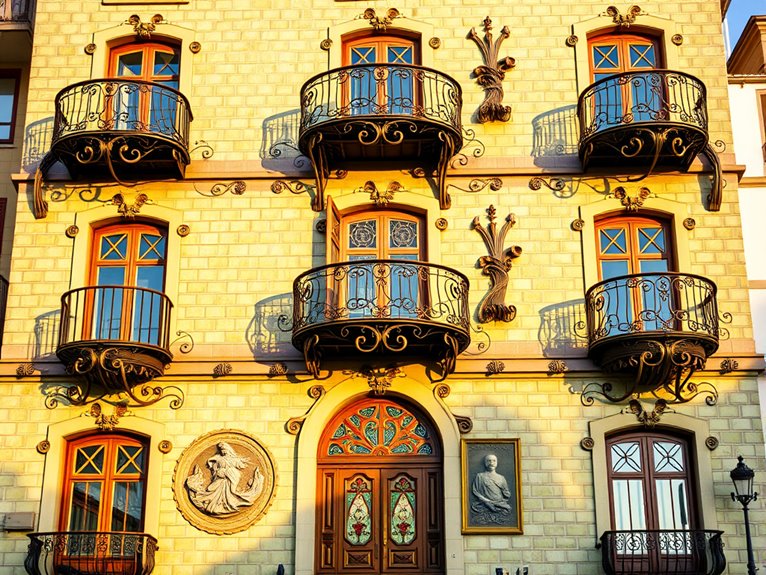
9 Art Nouveau Buildings in Paris You Shouldn’t Miss
I've uncovered nine remarkable Art Nouveau buildings in Paris that you won't want to miss! From Hector Guimard's groundbreaking Castel Béranger to Jules Lavirotte's dragon-adorned masterpiece at 29 Avenue Rapp, these architectural gems showcase the movement's signature organic forms and innovative designs. You'll discover elaborate metro entrances, ceramic-covered facades, and even historic restaurants like Maxim's and La Fermette Marbeuf. Each building tells a fascinating story of Paris's artistic revolution – and there's so much more to explore beneath their decorated surfaces!
The Iconic Castel Béranger by Hector Guimard
Standing proudly at 14 rue La Fontaine in Paris's 16th arrondissement, the Castel Béranger represents one of the most significant achievements of Art Nouveau architecture in France. Completed in 1898 by the visionary architect Hector Guimard, this apartment building became Paris's first official Art Nouveau structure and won the inaugural façade competition of the City of Paris in 1898.
The building's revolutionary design marked a dramatic departure from the rigid Haussmannian architecture that dominated Paris at the time. With its organic forms, intricate ironwork, and distinctive color palette combining green glazed brick and multicolored stonework, the Castel Béranger embodied the Art Nouveau movement's rejection of industrial standardization in favor of natural, flowing forms.
Quick Facts:
- Visiting Hours: Exterior viewing 24/7; interior visits by special arrangement only
- Best Time to Visit: Early morning or late afternoon for ideal lighting
- Photography: Exterior photography permitted; tripods may require permission
- Location: 14 rue La Fontaine, 16th arrondissement
- Metro: Jasmin (Line 9) or Michel-Ange Auteuil (Lines 9 and 10)
- Duration: 15-30 minutes for exterior viewing
- Status: Protected as a Historical Monument since 1992
Architectural Features:
The building's façade showcases Guimard's masterful integration of various materials, including sculptural ironwork resembling twisting vines, decorative ceramics, and distinctive green glazed bricks. The main entrance features an elaborate cast iron gate with organic forms that seem to writhe and twist, creating a dramatic first impression. The building's asymmetrical design and varied window shapes break from traditional architectural conventions, establishing a new visual language that would influence French architecture for decades.
Interior Elements:
While not generally open to the public, the building's interior continues the organic theme with sinuous handrails, decorative door frames, and custom-designed fixtures. Each apartment features unique details, from built-in furniture to specially designed door handles, demonstrating Guimard's commitment to creating a total work of art.
Pro Tips:
Morning visits offer the best lighting conditions for photography, particularly between 8-10 AM when the sun illuminates the façade's intricate details. Consider visiting during spring or fall when the surrounding trees complement the building's organic design elements without obscuring key architectural features. The neighborhood also contains other Guimard buildings, making it worth planning a walking tour to explore additional examples of his work.
Practical Advice:
While the Castel Béranger remains a private residence, visitors can still appreciate its revolutionary design from the street. Respect residents' privacy by maintaining a reasonable distance when photographing and avoiding blocking the entrance. The surrounding Auteuil neighborhood offers numerous cafés and restaurants, making it easy to combine your visit with lunch or dinner. For architecture enthusiasts seeking interior access, occasional guided tours are organized through specialized architectural organizations and during special events like European Heritage Days in September.
La Maison De Lavirotte: Jules Lavirotte's Masterpiece
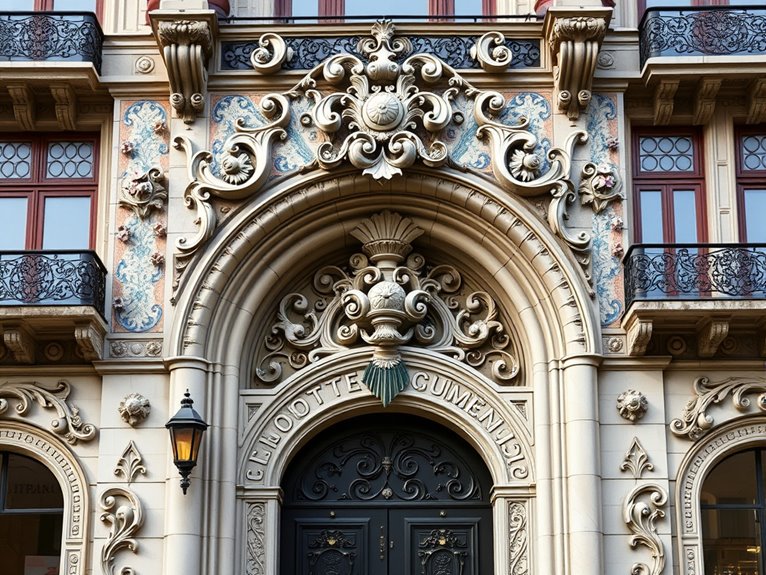
La Maison De Lavirotte stands as one of Paris's most striking examples of Art Nouveau architecture, commanding attention at 29 Avenue Rapp in the 7th arrondissement. Completed in 1901 by architect Jules Lavirotte, this UNESCO-listed building exemplifies the dramatic, nature-inspired aesthetics that defined the Art Nouveau movement, with its intricate facade featuring elaborate sculptural elements, ceramic tiles, and symbolic imagery.
The building's audacious design earned Lavirotte the City of Paris's prize for best facade in 1901, and today it continues to captivate architecture enthusiasts and casual observers alike. The structure represents more than just architectural beauty – it stands as a representation of the creative freedom and architectural innovation that characterized the Belle Époque period in Paris.
Quick Facts:
- Viewing Hours: Exterior viewable 24/7
- Photography: Best lighting early morning or late afternoon
- Location: 7th arrondissement, near Eiffel Tower
- Access: Free exterior viewing
- Tour Options: Available through select architectural tours
- Building Status: Private residence, interior not open to public
- Metro: Alma-Marceau (Line 9)
The Facade's Notable Features:
The building's main entrance serves as its most celebrated feature, with an extraordinary door frame carved from limestone and adorned with sensual, organic forms and mythological figures. The massive wooden door itself displays intricate carved details, while the surrounding ceramics, created by Alexandre Bigot, showcase a brilliant array of colors and patterns that were revolutionary for their time.
Architectural Elements:
The six-story structure employs a masterful combination of materials including glazed ceramic tiles, sculpted stone, wrought iron, and glass. The building's asymmetrical design incorporates curved lines and naturalistic forms, with balconies featuring elaborate ironwork and windows framed by sculptural elements that seem to grow organically from the facade.
Symbolic Details:
Perhaps most intriguing are the building's symbolic elements, including the controversial sculptural details that caused quite a stir in early 20th-century Paris. Sharp-eyed observers will notice the subtle integration of male and female forms throughout the facade, representing the period's fascination with natural and sensual themes.
Pro Tips:
The best photographs of La Maison De Lavirotte can be captured in the early morning hours before 9:00 AM when street traffic is minimal and the light is ideal. Consider visiting during spring or fall when the surrounding trees frame the building without obscuring its intricate details. For architecture enthusiasts, combining this visit with other nearby Art Nouveau buildings creates an enriching walking tour of the neighborhood.
Practical Advice:
While admiring the building's exterior, remember this is an active residential building – maintain a respectful distance and avoid blocking the entrance. The surrounding area offers excellent dining options and views of the Eiffel Tower, making it ideal to incorporate this architectural visit into a broader exploration of the 7th arrondissement. Consider downloading a detailed architectural guide beforehand to fully appreciate the symbolic elements and historical context of this remarkable structure.
Guimard's Art Nouveau Metro Entrances
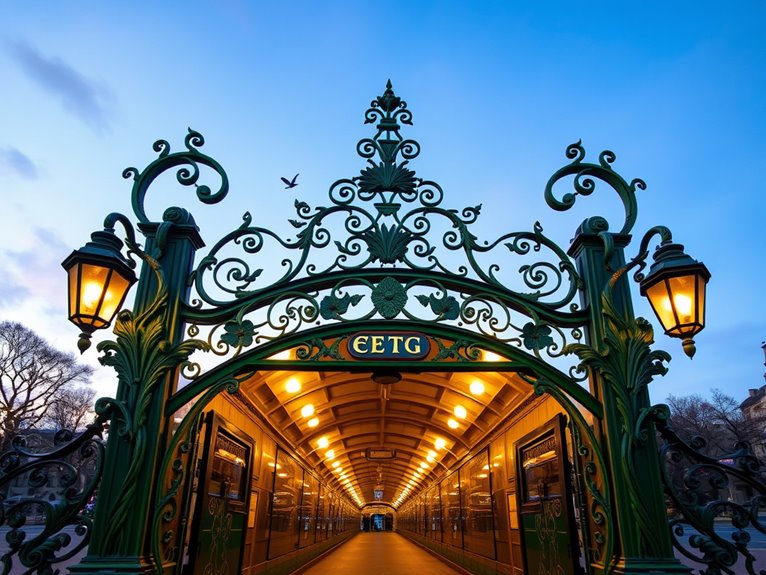
The Paris Metro system's entrances stand as some of the most recognizable symbols of Art Nouveau architecture, transforming mundane subway stations into magnificent works of art. Designed by Hector Guimard between 1900 and 1913, these distinctive entrances showcase the movement's characteristic organic forms, with their sinuous iron frameworks reminiscent of plant stems and flower petals.
Today, only 86 of the original 141 Guimard entrances remain, making them precious architectural landmarks that attract both architecture enthusiasts and casual tourists. These entrances represent a unique marriage of function and artistic expression, serving as gateways to Paris's underground transportation while simultaneously preserving an essential moment in architectural history.
Quick Facts:
- Best viewing times: Early morning or late afternoon for ideal lighting
- Photography permitted: Yes, no restrictions
- Conservation status: Protected historical monuments
- Original installation period: 1900-1913
- Number of entrance styles: Three main types (enclosed pavilions, covered entrances, simple balustrades)
- Access: Free to view from street level
- Best Metro lines for viewing: Lines 12, 13, and particularly Line 4
Notable Surviving Entrances:
Porte Dauphine Station (Line 2)
The crown jewel of Guimard's Metro entrances, featuring a rare glass-covered pavilion design known as an édicule. Located in the 16th arrondissement, this entrance represents the most elaborate of Guimard's designs and remains one of only two original enclosed pavilions still standing. Insider tip: Visit at sunset when the glass panels create stunning light effects.
Abbesses Station (Line 12)
Though not in its original location, this iconic entrance in Montmartre is the most photographed of all Guimard designs. The deep green cast iron structure features the classic "Métropolitain" lettering and signature whiplash curves. Insider tip: The entrance actually came from Hotel de Ville station and was relocated here in the 1970s.
Place de la Nation (Line 2)
A perfectly preserved example of the simpler balustrade style, featuring Guimard's characteristic plant-inspired motifs. This entrance demonstrates how even the most basic design maintained artistic integrity. Insider tip: The nearby Café de l'Avenue offers excellent viewing angles for photography.
Pro Tips:
For the best photography opportunities, visit during the "golden hour" just after sunrise when tourist crowds are minimal and lighting is ideal. Consider creating a walking tour that connects multiple Guimard entrances, starting at Porte Dauphine and ending at Place de la Nation, which allows you to see the evolution of designs while exploring different Paris neighborhoods.
Practical Advice:
Many entrances have undergone restoration work, so check current conditions before planning a specialized visit. Most entrances are located in busy areas, so be mindful of commuter traffic when photographing. For the most authentic experience, combine viewing the entrances with actual Metro rides to appreciate how these architectural masterpieces serve their intended purpose while maintaining their artistic significance.
The Ceramic House on Square Rapp
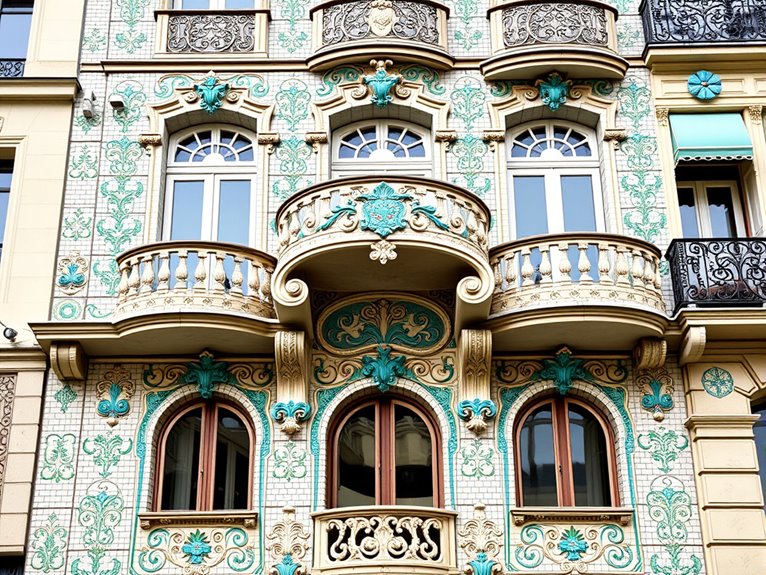
The Ceramic House (Maison de la Céramique) at 29 Square Rapp stands as one of Paris's most striking examples of Art Nouveau architecture. Designed by Jules Lavirotte in 1901, this six-story masterpiece showcases the movement's characteristic organic forms and innovative use of materials, particularly its distinctive ceramic facade that earned it the Prix de la Plus Belle Façade de Paris in 1901.
This architectural gem represents the peak of Art Nouveau experimentation in Paris, where Lavirotte pushed the boundaries of conventional design by incorporating elaborate ceramic decorations, sculptural elements, and sinuous forms. The building's facade features an extraordinary display of polychrome ceramics, imaginative creatures, and flowing botanical motifs that exemplify the movement's rejection of industrial standardization in favor of naturalistic, handcrafted artistry.
Quick Facts:
- Best viewing times: Early morning or late afternoon for ideal lighting
- Photography permitted: Yes (exterior only)
- Access: Public viewing of exterior; interior private residences
- Location: 7th arrondissement, near Eiffel Tower
- Nearest Metro: Alma-Marceau (Line 9)
- Best season: Spring/Fall for clearest visibility
- Walking tours available: Yes, as part of Art Nouveau circuits
The Facade:
The building's most remarkable feature is its ceramic-decorated facade, created in collaboration with Alexandre Bigot, a renowned ceramicist of the era. The entrance portal deserves special attention, with its asymmetrical arch crowned by an elaborate sculptural composition featuring feminine figures and fantastic creatures. Insider tip: Look for the hidden signature of Lavirotte himself, cleverly integrated into the decorative elements near the ground floor.
Architectural Details:
The building showcases characteristic Art Nouveau elements including curved balconies, organic-inspired ironwork, and intricate window frames that seem to grow from the facade like living organisms. Each floor presents different decorative themes, rewarding careful observation from ground to roof level. The color palette of greens, blues, and earthy tones was specifically chosen to change appearance throughout the day as natural light shifts.
Pro Tips:
The best photographs can be taken from the opposite side of Square Rapp, where you can capture the full height of the facade. Visit during the "golden hour" (just after sunrise or before sunset) when the ceramics take on a particularly magical glow. For architecture enthusiasts, combining this visit with nearby Art Nouveau buildings on Avenue Rapp creates a perfect walking tour of the style.
Practical Considerations:
While the building's interior remains private, visitors can appreciate the facade from the public square. The area tends to be quieter than other tourist zones in Paris, making it ideal for unhurried observation and photography. Consider visiting on weekday mornings when local traffic is minimal and lighting conditions are advantageous for appreciating the ceramic details.
La Fermette Marbeuf: Hidden Restaurant Gem
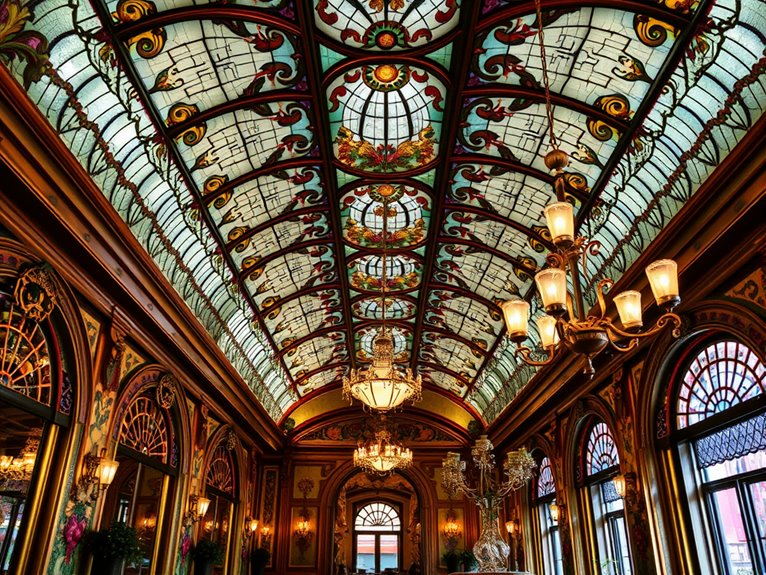
Tucked away in Paris's 8th arrondissement, La Fermette Marbeuf stands as one of the city's most stunning examples of Art Nouveau architecture and design. Originally opened in 1898 as a dairy restaurant, this hidden gem showcases an extraordinary 1900 dining room that remained concealed behind a false ceiling for nearly 80 years until its accidental discovery during renovations in 1978.
The restaurant's centerpiece is its magnificent glass-roofed dining room, adorned with elaborate peacock motifs, intricate floral patterns, and luminous stained glass windows. The space exemplifies the height of Belle Époque elegance, combining the natural forms and flowing lines characteristic of Art Nouveau with exceptional craftsmanship that has earned it historical monument status.
Quick Facts:
- Opening Hours: 12:00-14:30 and 19:00-22:30, daily
- Price Range: €45-80 per person for dinner
- Reservation Required: Yes, especially for dinner and weekends
- Dress Code: Smart casual
- Photography: Allowed without flash
- Accessibility: Ground floor access
- Languages: French and English menus available
The Historic Dining Room
The main dining room, known as the "1900 Room," represents the pinnacle of Art Nouveau interior design. Created by Emil Hurtré, the space features hand-painted ceramic tiles, elaborate metalwork, and a stunning glass ceiling that bathes diners in natural light. The peacock-themed decorations and mirror arrangements create an atmosphere of timeless elegance while serving traditional French cuisine. Located at 5 Rue Marbeuf, the restaurant sits just steps from the Champs-Élysées.
The Culinary Experience
La Fermette Marbeuf offers a menu that combines traditional French gastronomy with contemporary touches. The restaurant maintains its historic connection to its dairy origins through signature dishes featuring fine French cheeses and cream-based sauces. An insider secret: request table 12 or 14 for the best views of the art nouveau details while dining.
Pro Tips:
The best time to appreciate the stunning glass ceiling is during lunch service when natural light streams through, creating an ethereal atmosphere. Book your reservation at least two weeks in advance and request the 1900 Room specifically, as the restaurant has other dining areas that don't feature the iconic Art Nouveau décor. Consider visiting during shoulder season (March-April or September-October) when tourist crowds are thinner.
Practical Advice:
Photography is permitted but be mindful of other diners' privacy. The restaurant offers a prix fixe menu that provides better value than à la carte options. For the best experience, arrive 15 minutes before your reservation to admire the architectural details and perhaps enjoy an aperitif in the entrance area, which features additional Art Nouveau elements often overlooked by hurried diners.
29 Avenue Rapp: The Dragon Door Building
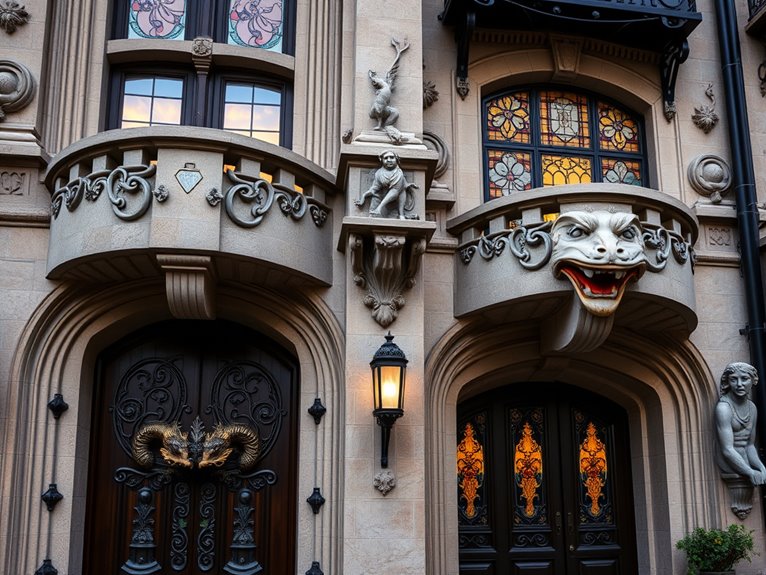
The Dragon Door Building: Art Nouveau's Most Fantastical Entrance
———————————————————–
Located at 29 Avenue Rapp in Paris's 7th arrondissement, the Dragon Door Building stands as one of the most spectacular examples of Art Nouveau architecture in the French capital. Designed by Jules Lavirotte in 1901, this building captivates visitors with its extraordinary entrance portal, dominated by a massive salamander-dragon sculpture that seems to guard the doorway with mystical presence.
The building earned its nickname from the imposing dragon motif, but the entire façade is a masterpiece of Art Nouveau design, featuring intricate organic forms, symbolic sculptures, and elaborate ironwork. Beyond its artistic significance, the structure won the City of Paris's competition for best façade of 1901, cementing its place in architectural history and making it an essential stop for both art enthusiasts and casual admirers.
Quick Facts:
- Best viewing times: Early morning or late afternoon for ideal lighting
- Photography permitted: Yes (exterior only)
- Closest Metro: Alma-Marceau (Line 9)
- Building status: Private residence, exterior viewing only
- Peak tourist times: 10 AM – 4 PM
- Duration of visit: 15-30 minutes recommended for appreciation
The Dragon Door's Distinctive Features:
The building's most remarkable feature is its entrance portal, featuring a salamander-dragon wrapped around the doorway, created from glazed stoneware. The surrounding sculptural elements include female figures, plants, and symbolic creatures, all executed in the characteristic flowing lines of Art Nouveau. The door itself, made of intricately carved wood and adorned with bronze fixtures, showcases the period's attention to detail and craftsmanship. Insider tip: Look for the hidden faces and creatures integrated into the architectural details – there are dozens that most visitors miss.
Location and Access:
The building is situated near the Eiffel Tower, making it easily combinable with other major attractions. While the interior is private, the exterior can be viewed freely from the street. Address: 29 Avenue Rapp, 75007 Paris. The location offers excellent photo opportunities, particularly in the golden hours of early morning or late afternoon when the sculptural details cast dramatic shadows.
Pro Tips:
For photography enthusiasts, visit on overcast days when the diffused light reveals the intricate details without harsh shadows. Consider bringing a zoom lens to capture the upper-level decorative elements. The building's western exposure means afternoon light illuminates the façade best, though morning visits offer the advantage of fewer tourists blocking the view.
Practical Advice:
While the Dragon Door Building is a public street attraction, remember it's a residential building. Maintain a respectful distance and avoid blocking the entrance. For the best experience, combine this visit with other Art Nouveau sites in the 7th arrondissement, including nearby buildings designed by Hector Guimard. Consider downloading a detailed Art Nouveau walking tour map to maximize your architectural exploration of the area.
Maxim's Restaurant: Art Nouveau Elegance
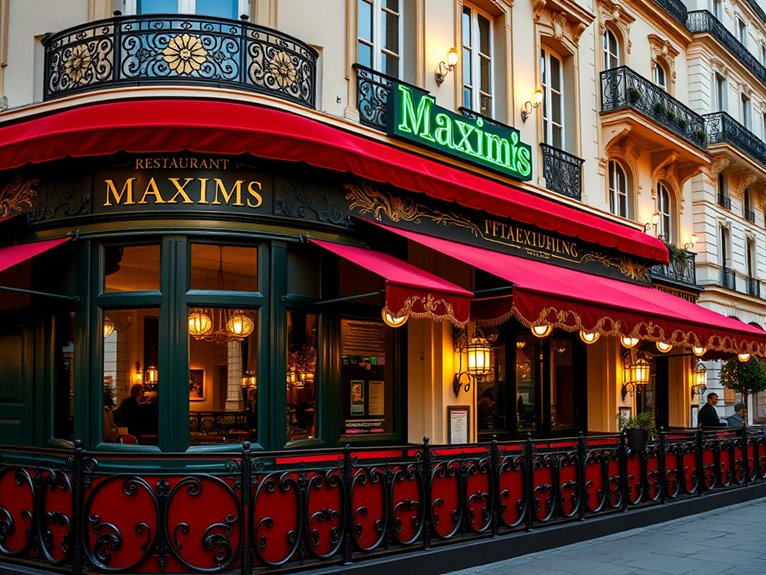
Maxim's Restaurant stands as one of Paris's most iconic examples of Art Nouveau design, embodying the luxurious spirit of the Belle Époque era since its establishment in 1893. The restaurant's interior, largely preserved from its golden age, showcases the flowing lines, natural motifs, and ornate decorative elements that define the Art Nouveau movement, making it both a culinary destination and a living museum of this distinctive architectural style.
Beyond its architectural significance, Maxim's represents a unique intersection of Parisian cultural history, gastronomy, and art. The restaurant has hosted countless celebrities, royalty, and cultural figures throughout its storied history, while maintaining its reputation as one of the city's most prestigious dining establishments. The three-story building houses not only the restaurant but also a museum dedicated to the Art Nouveau period, offering visitors a thorough immersion into this transformative artistic era.
Quick Facts:
- Opening Hours: Dinner service 7:00 PM – 11:30 PM (closed Sundays and Mondays)
- Price Range: €150-300 per person for dinner
- Dress Code: Formal (jacket required for men)
- Reservations: Essential, recommended 2-3 months in advance
- Museum Hours: Tuesday to Sunday, 2:00 PM – 5:30 PM
- Photography: Permitted in museum, limited in restaurant
- Location: 3 Rue Royale, 75008 Paris
The Restaurant Experience:
The ground floor restaurant showcases the epitome of Art Nouveau design, featuring original mirrors, brass fixtures, and sinuous woodwork that create an atmosphere of timeless elegance. The ceiling's elaborate floral motifs and the authentic period lighting fixtures transport diners to the height of the Belle Époque. Insider tip: Request Table 10, historically reserved for regular patron Aristotle Onassis, offering the best view of both the restaurant's interior and the flowing movement of service.
The Art Nouveau Museum:
Located on the upper floors, Pierre Cardin's private collection of Art Nouveau artifacts and furniture provides unique context for the restaurant's design. The museum features over 550 pieces, including works by masters like Louis Majorelle and Émile Gallé. Insider tip: The third-floor bedroom recreation, complete with original Tiffany lamps, offers the most photogenic vantage point for capturing the essence of Art Nouveau design.
Pro Tips:
For the ultimate experience, combine a museum visit with dinner reservations. Arrive for the museum tour at 4:30 PM to enjoy the collection without crowds, then enjoy an aperitif at the bar before dinner service begins. The soft evening lighting enhances the restaurant's architectural details and creates the most flattering atmosphere for both photography and dining.
Practical Advice:
When planning your visit, consider that the restaurant maintains strict dress code requirements and booking protocols. The most coveted dining times are between 8:00 PM and 9:30 PM, particularly during peak tourist seasons (June-September). For the best value and experience, opt for the fixed-price historical menu, which features dishes from different eras of the restaurant's illustrious past, complemented by wine pairings selected by the house sommelier.
Bouillon Racine: The Historic Eatery
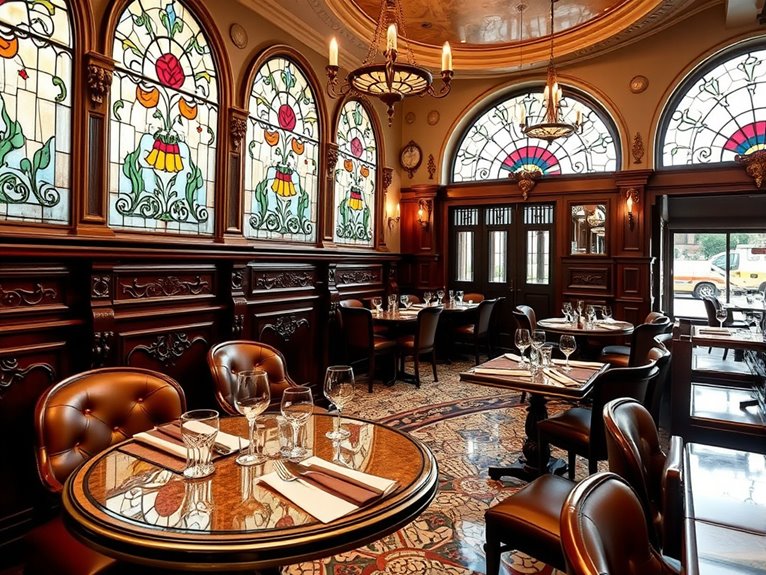
Art Nouveau's Culinary Jewel: Bouillon Racine
—————————————-
Nestled in Paris's Latin Quarter, Bouillon Racine stands as one of the city's most exquisite examples of Art Nouveau architecture combined with culinary heritage. Established in 1906, this former working-class restaurant has maintained its original splendor, featuring stunning carved woodwork, intricate mirrors, and ceramic tiles that transport diners to the Belle Époque era.
Beyond its architectural significance, Bouillon Racine represents the fascinating history of Parisian bouillons – affordable restaurants that served nourishing meals to workers in the late 19th century. Today, while preserving its historical essence, it offers refined French cuisine in a setting that has earned it classification as a Historic Monument in 1995.
Quick Facts:
- Price Range: €30-60 per person
- Reservation: Highly recommended, especially for dinner
- Dress Code: Smart casual
- Dietary Options: Vegetarian options available
- Peak Hours: 12:30-2:00 PM, 7:30-9:30 PM
- Languages: English menus available
- Credit Cards: All major cards accepted
The Restaurant Experience:
The main dining room showcases masterful Art Nouveau detailing, with sculpted wooden frames, etched glass panels, and brass fixtures creating an atmospheric dining environment. The original mirrors and ceramic tiles have been meticulously preserved, making every angle photo-worthy. Located at 3 Rue Racine, 75006 Paris, the restaurant is open Tuesday through Saturday, 12:00-2:30 PM and 7:00-10:30 PM. Insider tip: Request a table in the mezzanine area for the best views of the architectural details and the bustling dining room below.
The Menu:
The cuisine bridges traditional French classics with contemporary interpretations. Signature dishes include coq au vin and beef bourguignon, while seasonal menus showcase fresh market ingredients. The wine list features carefully selected French wines, with many affordable options. Insider tip: The pre-theater menu (served 6:00-7:30 PM) offers excellent value and includes some of their most popular dishes.
Pro Tips:
For the ideal experience, visit during late afternoon light (around 5:00 PM in winter, 7:00 PM in summer) when the natural light streaming through the windows creates magical reflections off the mirrors and brass details. Photographers should bring cameras capable of low-light shooting, as flash photography can disturb other diners. Consider booking for late lunch when the restaurant is less crowded and the light is ideal for photography.
Practical Advice:
While Bouillon Racine welcomes tourists, it maintains its authentic Parisian character. Make reservations at least a week in advance, especially for weekend dinners. The restaurant is a 5-minute walk from Odéon metro station (lines 4 and 10). For those interested in the building's Art Nouveau features, arrive 15 minutes before your reservation to explore the details of the entrance and stairway areas.
The Mysterious Immeuble Jassedé
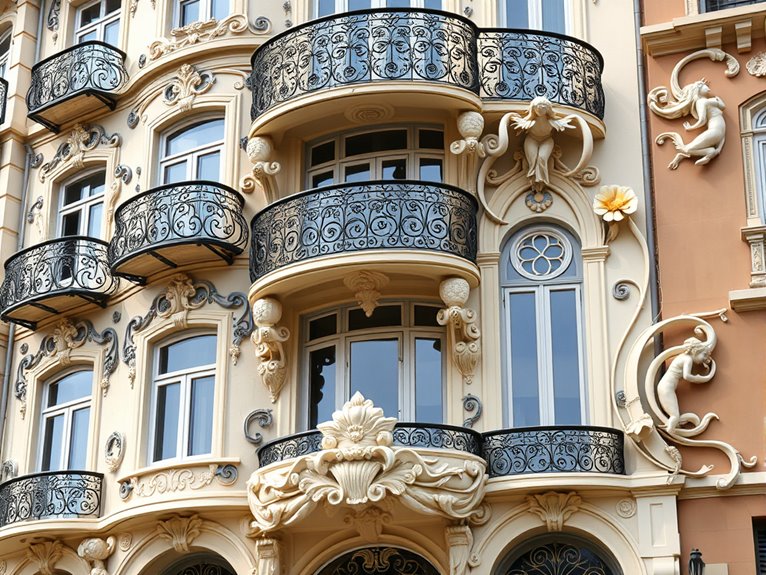
Tucked away in Paris's 16th arrondissement, the Immeuble Jassedé stands as one of the most enigmatic examples of Art Nouveau architecture in the city. Designed by architect Jules Lavirotte in 1903, this remarkable building captivates visitors with its fantastical façade, featuring intricate organic forms, mythological creatures, and symbolic elements that continue to intrigue art historians and architecture enthusiasts alike.
The building's mysterious appeal lies not only in its striking appearance but also in its rich historical context. Commissioned by ceramic manufacturer Alexandre Bigot, who provided the elaborate tiles adorning the façade, the Immeuble Jassedé represents a flawless marriage of artistic vision and technical innovation that characterized the Art Nouveau movement. Its hidden details and architectural secrets make it an essential stop for anyone exploring Paris's architectural heritage.
Quick Facts:
- Location: 41 Rue de Passy, 75016 Paris
- Best viewing times: Early morning or late afternoon for ideal lighting
- Photography permitted: Yes (exterior only)
- Closest Metro: La Muette (Line 9)
- Building status: Private residence, exterior viewing only
- Peak tourist times: 11:00 AM – 4:00 PM
- Architecture style: Art Nouveau
Notable Features:
The Façade
The building's most striking feature is its ceramic-tiled façade, displaying an intricate composition of flowing lines, floral motifs, and mythological figures. The color palette ranges from deep blues to warm earthen tones, creating a mesmerizing visual effect that changes with the day's light. Insider tip: Look for the hidden face of a woman near the third-floor balcony, said to be Lavirotte's muse.
The Entrance Portal
The main entrance is a masterpiece of Art Nouveau design, featuring an elaborate doorway framed by sculptural elements and decorated with symbolic motifs. The bronze door handles are shaped like intertwining serpents, a common Art Nouveau motif. Insider tip: Visit during the morning hours when the entrance is typically cleaned, and the door may be temporarily open, offering a rare glimpse of the interior vestibule.
The Balconies
Each floor features uniquely designed wrought-iron balconies that seem to grow organically from the building's façade. The intricate metalwork demonstrates the period's exceptional craftsmanship and attention to detail. Insider tip: The best photographs can be captured from the small café across the street, which offers a prime vantage point.
Pro Tips:
For the best appreciation of the Immeuble Jassedé's architectural details, visit during the "golden hour" just before sunset, when the lowering sun highlights the relief work and ceramic tiles. Consider bringing binoculars to examine the upper-floor details that are difficult to see from street level. Photography enthusiasts should visit on overcast days when diffused light reduces harsh shadows on the façade.
Practical Advice:
While the Immeuble Jassedé is situated in a residential area, visitors should maintain respectful behavior as it remains a private building. The surrounding neighborhood offers several other Art Nouveau gems within walking distance, so plan to incorporate this visit into a larger architectural walking tour of the 16th arrondissement. The building is best reached by taking Metro Line 9 to La Muette station and walking approximately 5 minutes along Rue de Passy.
